This is a page within the www.staffshomeguard.co.uk website. To see full contents, go to SITE MAP.
MEMORIES
AND INFORMATION - WORCESTERSHIRE
Lt.-Col. F. H. LIDDELL, M.C.
|
The county town of Shrewsbury in Shropshire
was defended by the 1st
Salop
Battalion. At the beginning
Lt.-Col. W.R.H.
Dann D.S.O. was in command but later responsibilty
fell to Lt.-Col. F.H.
Liddell, M.C. who was promoted from within the
Battalion where he had previously served as a Company
Commander with the rank of Major.
Frank
Liddell had had a distinguished Great War record,
winning the Military Cross and being demobilised with
the rank of Major after the Armistice. It is
unsurprising that he was involved in the very earliest
days of the Home Guard in his home town of Shrewsbury.
Fragments of those times survive: he kept a scrapbook
of documents and images and thanks to the generosity
of his granddaughter this information can now be
published in this website.
There is just one
group photograph. This appears to have been taken
within the grounds of Shrewsbury Castle and shows the
Battalion officers. Its date is unknown.

Frank Liddell was clearly a man of artistic bent
and able to juggle the demands of Home Guard duty,
personal life and other pursuits to a remarkable
degree. This letter of 14th April 1941 from
General
Gordon-Finlayson, G.O.C. of Western Command refers to
a dramatic production which saw performances in
Chester, Liverpool and almost certainly elsewhere, and
in which Frank was very much involved. It is unclear
whether he was the writer, producer or the director,
or all three. What a pity that the script seems not to
have survived!
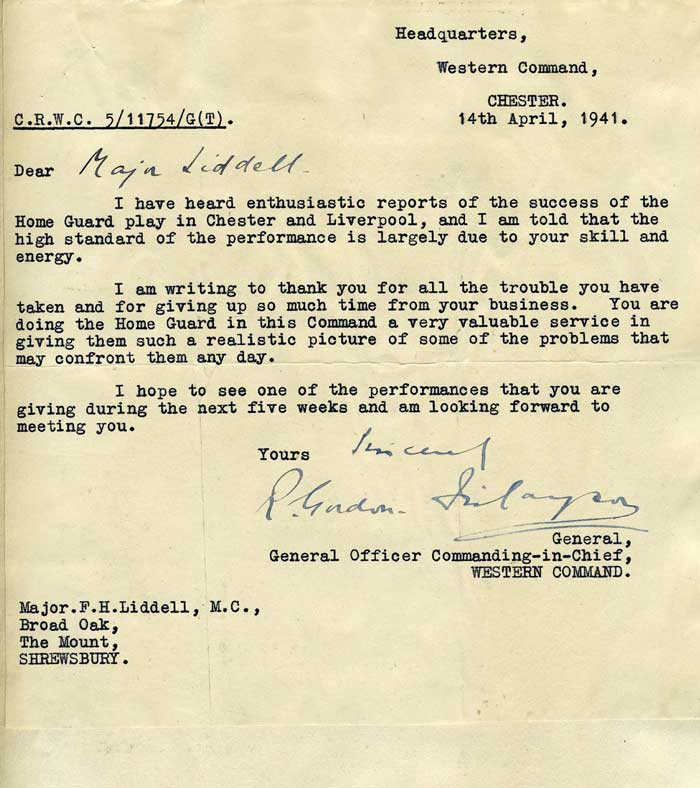
The following two images are of a significant
building and of, presumably, its grounds in which a
Home Guard exercise is taking place. Much scrutinising
of maps appears to be occurring. Whether this is in or
near to Shrewsbury has yet to be confirmed.
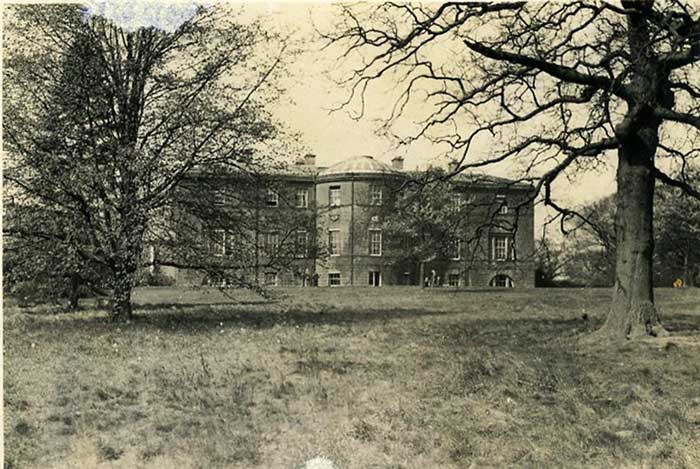
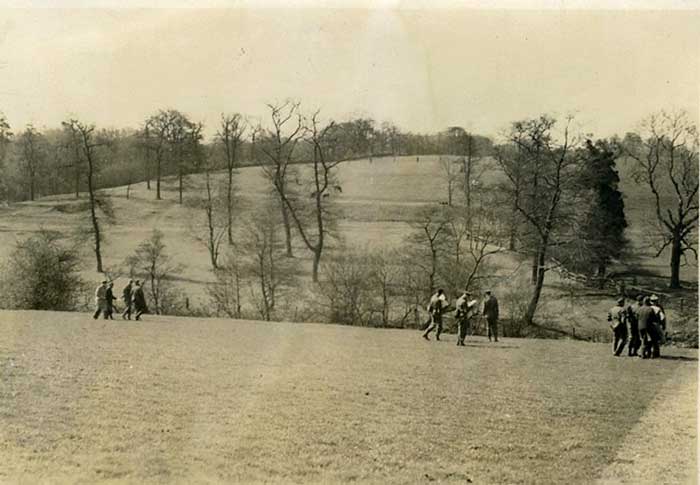
A memorandum from Major W.S.B. Tucker, C.O. of the
Battalion’s "Z" Company dated 23rd February 1943
indicates that humour certainly had its part in the
life of the Shrewsbury Home Guard alongside the long
hours of hard work . The enclosure details the woes of
life in the service and would have no doubt rung many
bells amongst members. It was certainly deemed worthy
of preservation by the Battalion Commanding Officer.
In the covering note there is also a very clear
inference as to Major Tucker’s day job.
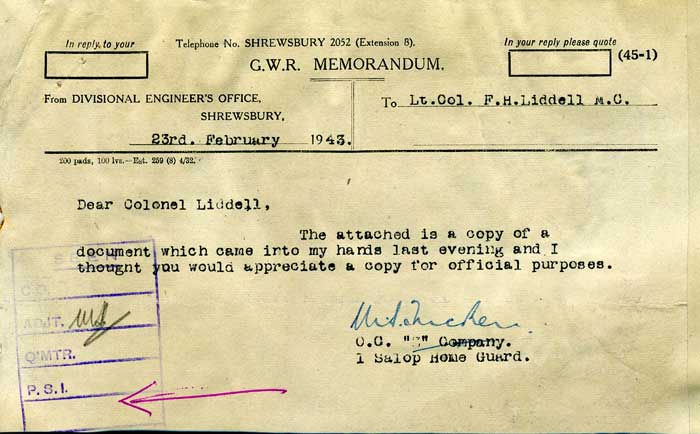
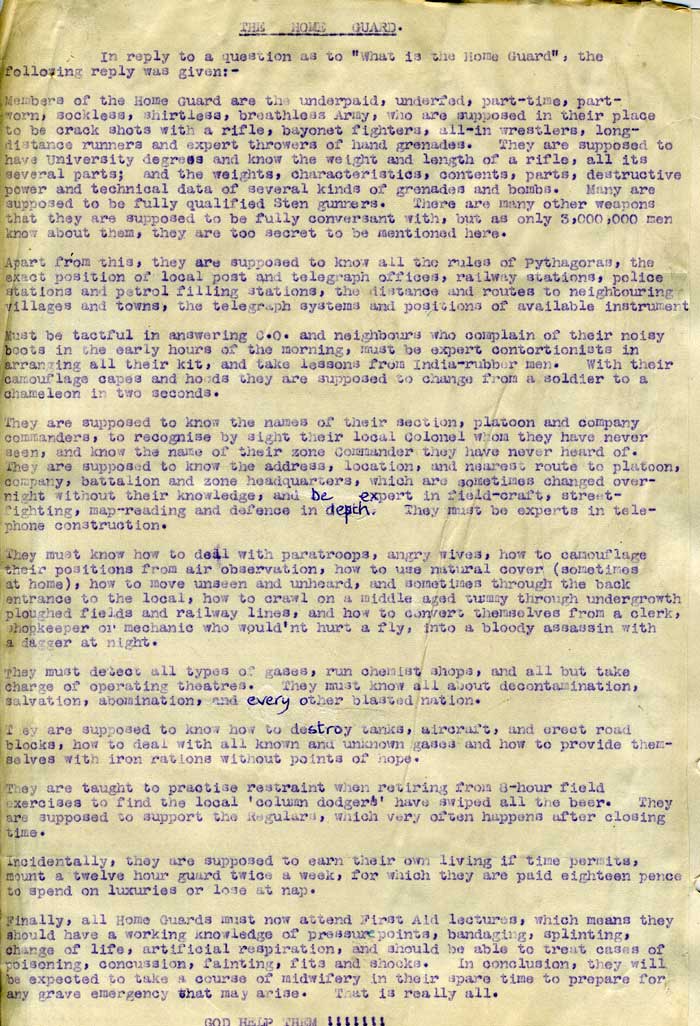
Work continued, day in and day out. The third
anniversary, in May 1943, passed.
From October of the same year, 1943, a letter
survives from W.C. Green, Zone Commander and possibly
an officer in the Regular Army, announcing his
departure for pastures new and expressing thanks for
loyalty and support.
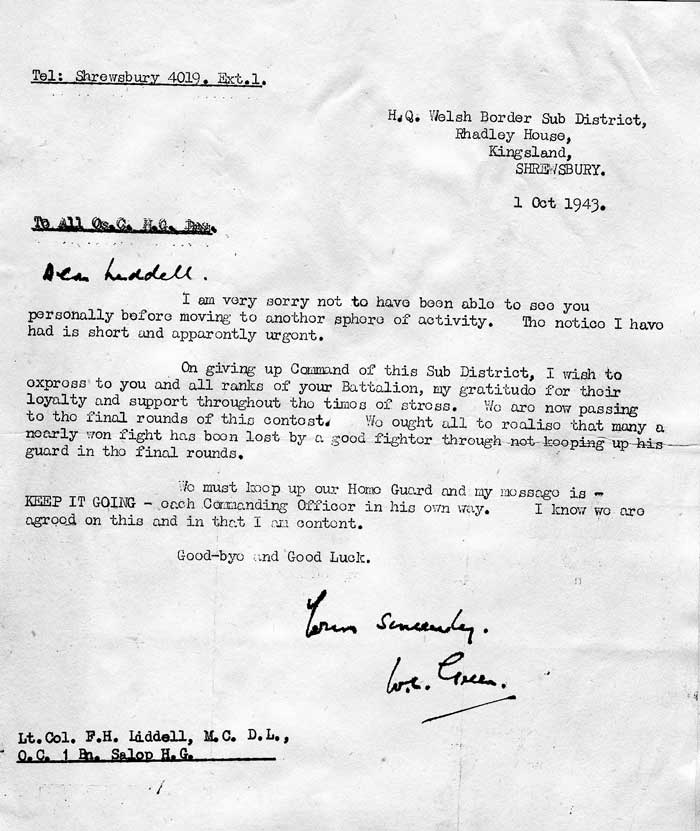
We are reminded of Frank Liddell’s creative and
organisational abilities by records of the Tattoo
which was held in The Quarry at Shrewsbury on
Saturday, August 19th, 1944 in aid of the Shrewsbury
Red Cross Appeal. He is shown in the programme as
Tattoo Director and from his surviving papers we can
see detailed instructions for the event.
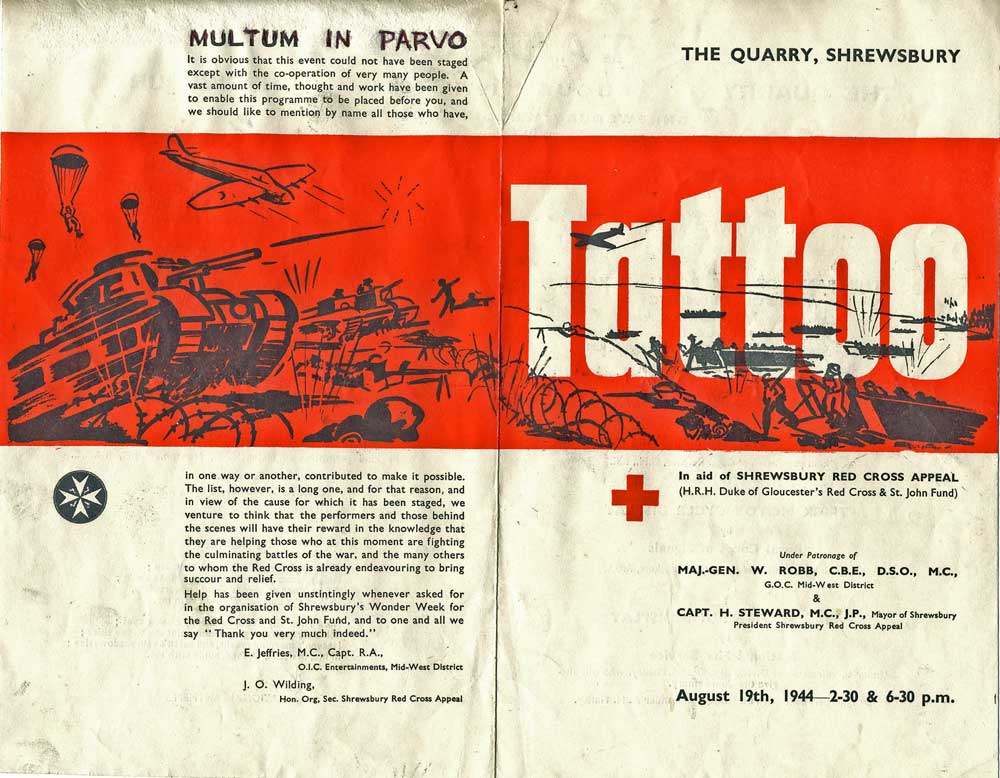
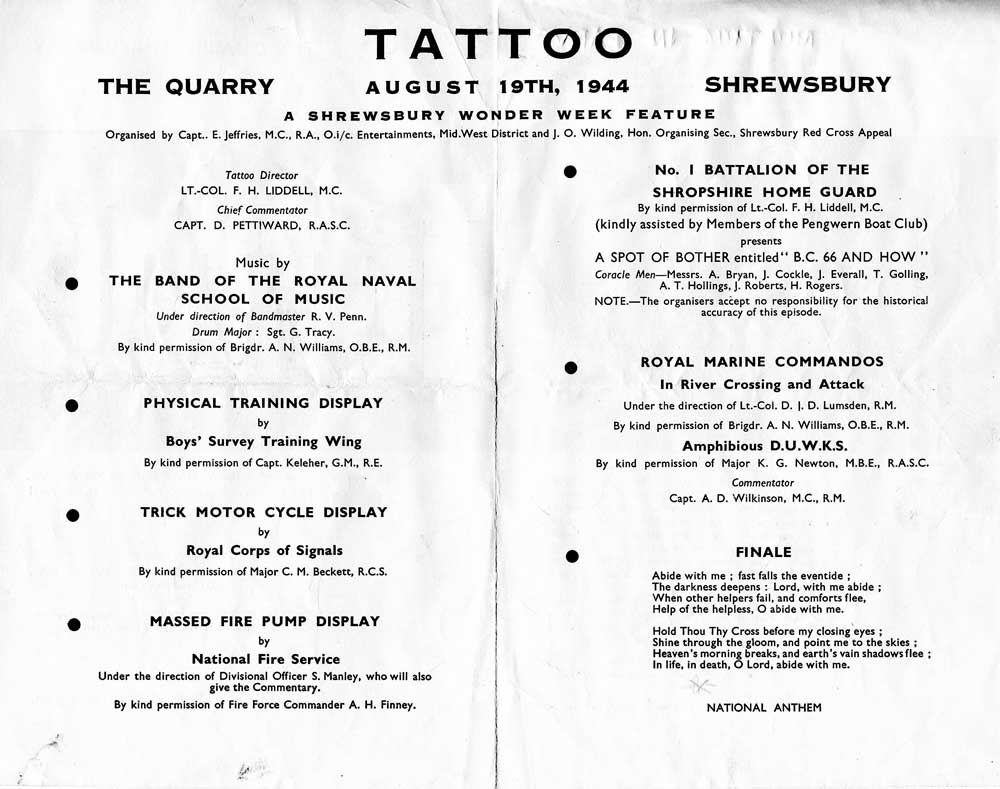
(Click
here or on either of the two programme images above
to see Frank Liddell's detailed planning for this
event).
A further production occurred on another date in
1944: a play entitled “Up Guards and At ’Em” and
subtitled “A Short Play Dedicated to the Home Guards
by the Anonymous Authors”. The producer is F.H.
Liddell supported by the Stage Manager,
G.M. Crick. It
appears that the actors are all members of the
K.S.L.I. stationed in the town. The date of this
production is unknown but the time in which the play
is set is clearly the period of several weeks
following D-Day on June 6, 1944. It must therefore be
a different production from that of 1941.
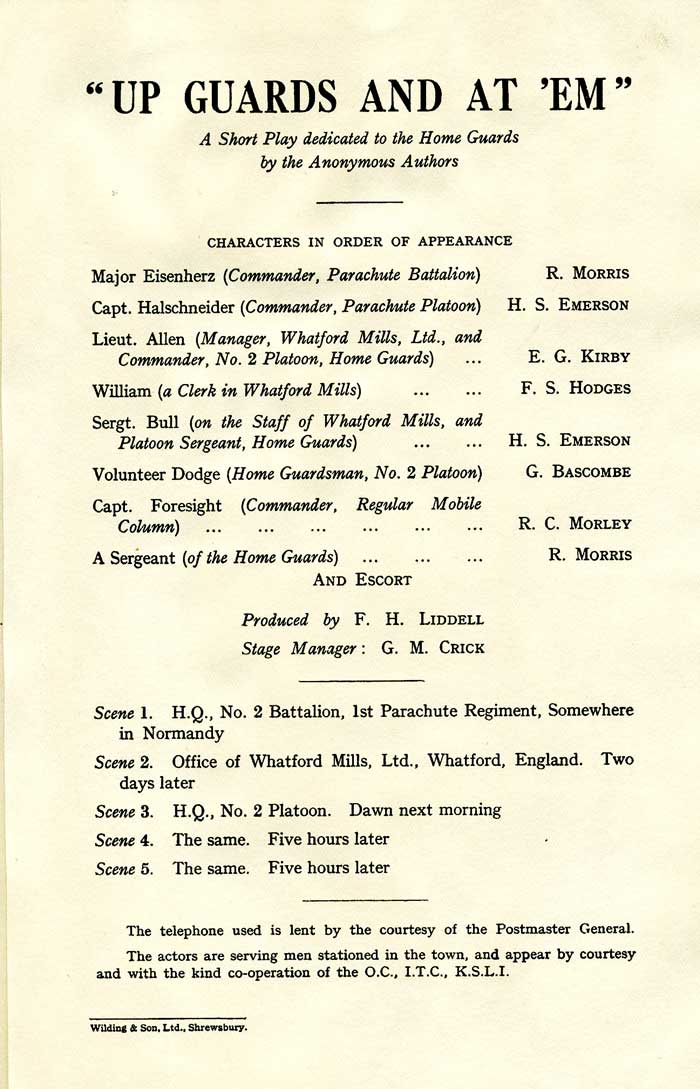
After 4½ long years the need for the services of
the Home Guard was rapidly disappearing and the
organisation started to wind down. There is
unfortunately within Frank Liddell’s papers little
evidence of all the effort which must have been put in
over the years in order to make the 1st Shropshire
Battalion a formidable fighting force - constant
training, frequent exercises, guard duty, parades,
mountains of paperwork, evenings and most weekends
dedicated to the service. Nor of the comradeship which
evolved and which was no doubt a significant legacy
for this and all other Home Guard units. Perhaps we
can imagine the relief and sense of achievement felt
by him and his comrades as the end came in December
1944; and also their desire to mark the occasion.
The officers of the Battalion had a farewell
dinner on Wednesday, November 22nd at
Morris’s Café.
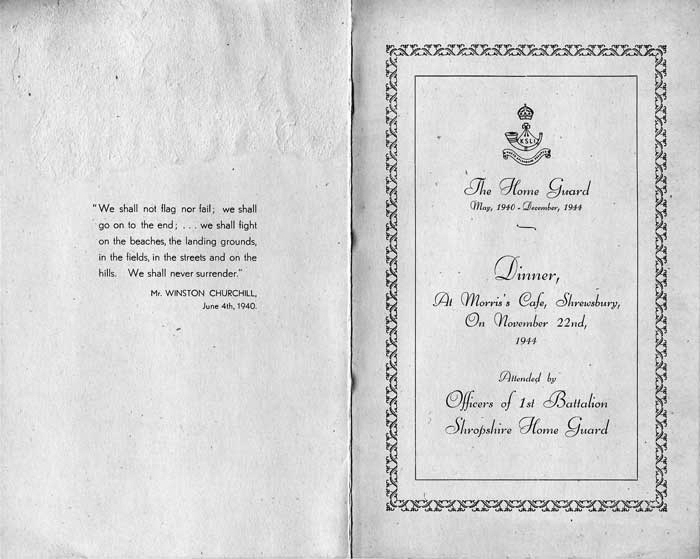
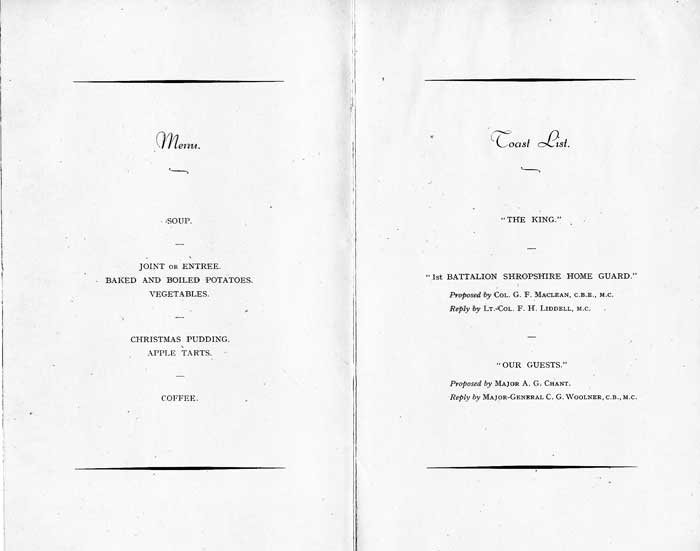
On Sunday, December 2nd there was a formal,
farewell parade through the middle of
Shrewsbury and this was reported in the local
newspaper a day or two later.
Social events continued. There was a dinner
organised by the 2223 Home Guard Motor Transport
Company - a unit of whose function staffshomeguard is
not currently aware - which was held, again, at
Morriss's Cafe. Frank Liddell had the job of proposing
the toast to the hosts.
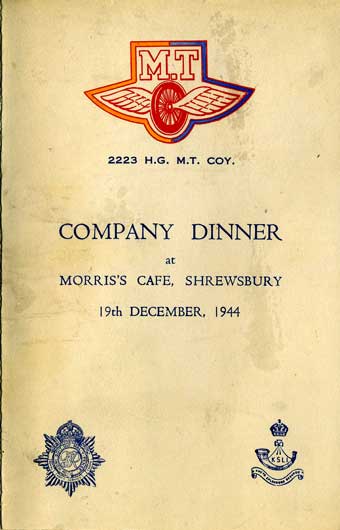
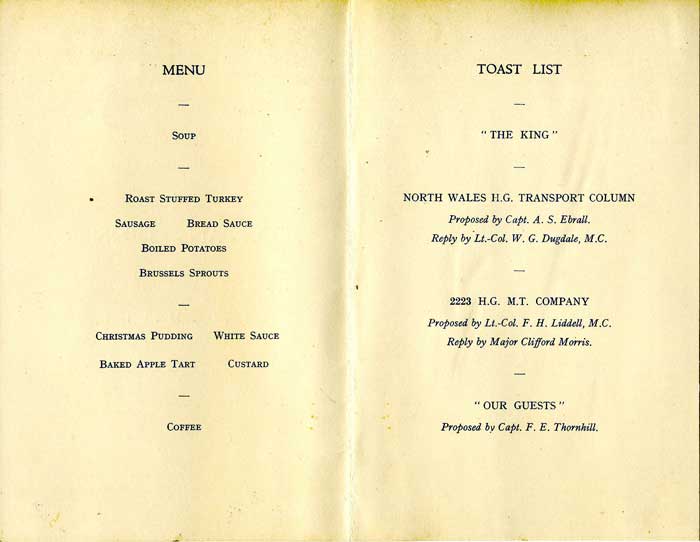
Letters of commendation and farewell were
received.
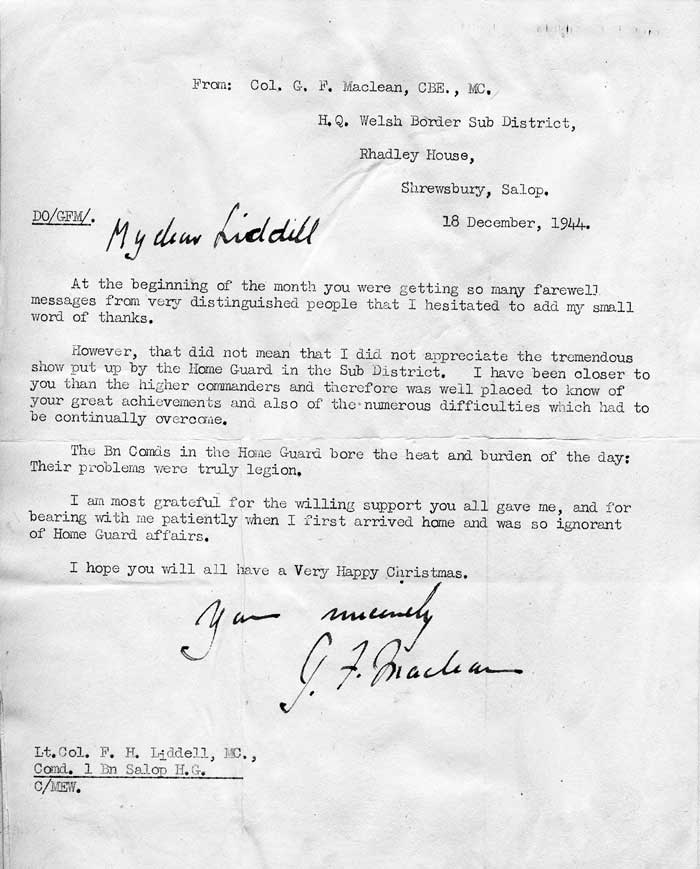

And so ended Frank Liddells's second military
career. Not recorded are the further weeks of effort
as the Battalion's affairs were tidied up, equipment
returned, reports made and, to the chagrin of
future Home Guard historians, large bonfires no doubt lit to
dispose of the mountains of now redundant paperwork.
Whilst the service was not formally wound up
until 1945, December 31st 1944 was officially regarded
as the end of each individual's service and Frank
Liddell's certificate of service reflects that. Behind
it lies countless thousands of hours of voluntary
effort, physical, mental and emotional, leading a unit
which was prepared to give its all in the defence of
its town and its country, had the need arisen.
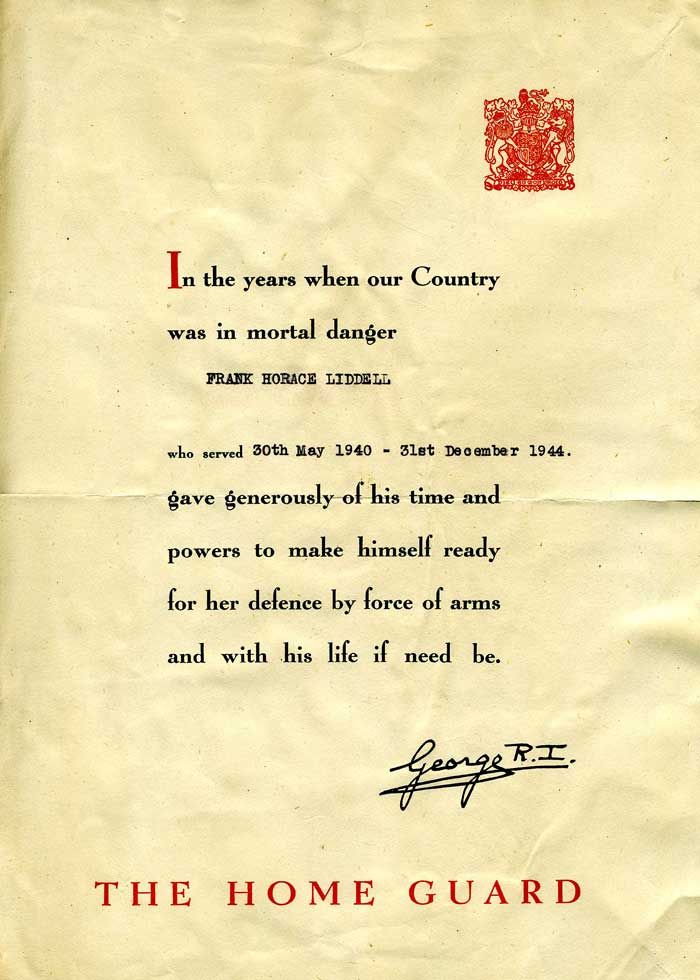
F rank Liddell continued to hold a significant position
in the life of Shrewsbury after the war. He had a
close relationship with the Dutch town of Zutphen and
organised consignments on behalf of the citizens of
Shrewsbury to relieve hardship in the difficult months
of 1945. Later he was instrumental in the organisation
of a twinning of the two towns which lasts to this
day. Professionally he continued to run his business:
the Della Porta department store in High Street which
later became part of the House of Fraser (Rackhams).
And personally, it seems, he was well-known, not only
for his many qualities but also for a vast collection
of gramophone records. rank Liddell continued to hold a significant position
in the life of Shrewsbury after the war. He had a
close relationship with the Dutch town of Zutphen and
organised consignments on behalf of the citizens of
Shrewsbury to relieve hardship in the difficult months
of 1945. Later he was instrumental in the organisation
of a twinning of the two towns which lasts to this
day. Professionally he continued to run his business:
the Della Porta department store in High Street which
later became part of the House of Fraser (Rackhams).
And personally, it seems, he was well-known, not only
for his many qualities but also for a vast collection
of gramophone records.
In the early 1950s a
cartoon of him, in the contemporary style of the time,
was drawn by an unknown artist named MAC (not the
later Daily Mail cartoonist of the same name). This
cartoon relates to his military background in general
- including his remarkable and rapid rise from humble
Private in the Great War - and not specifically to his
Home Guard years. But the image represents a
mature Frank not so many years after his Home Guard
service between 1940 and 1944; and through it we may
perhaps picture the man at that time, striding forward
in battledress to tackle the job in hand, at the same
time exuding enthusiasm, energy and good cheer.
Associated pages within this website are:
In Memory of
Lt.-Col. Frank H.
Liddell
and
all his comrades in the
1st Shropshire Battalion |
ACKNOWLEDGEMENT
Staffshomeguard is
most grateful to Mandy Peat, Col. Liddell's
grand-daughter, for generously passing on
images and information about her grandfather
and permitting their publication in this
website.
FURTHER
INFORMATION
Further information about the
Home Guard in Shrewsbury is contained
elsewhere in various parts of this website. To view the
Shropshire summary page, please use the
Shropshire Page link below.
And if you
can add anything to the history of the
Shropshire Home
Guard, please contact staffshomeguard via the
Feedback link.
|
x119 June 2015;
updated November 2015 |
|
|